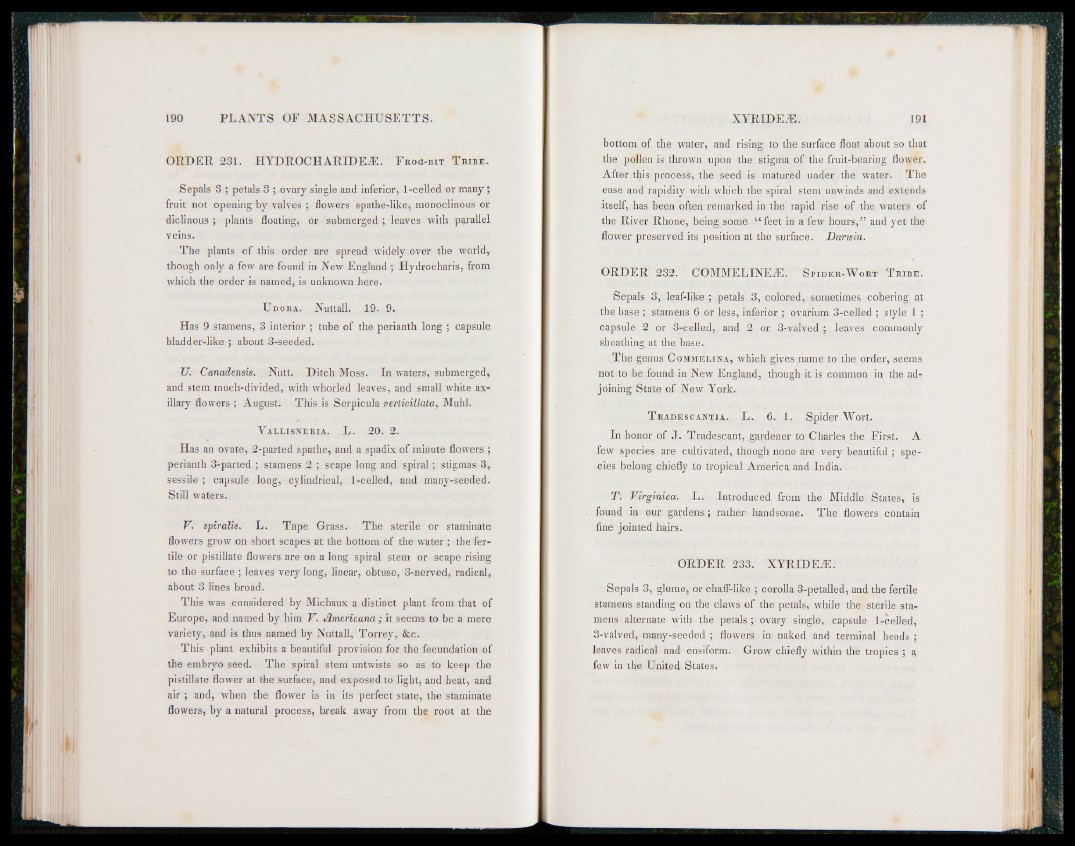
ORDER 231. HYDROCHARIDEiE. F rog-bit T r ib e .
Sepals 3 ; petals 3 ; ovary single and inferior, 1-celled or many;
fruit not opening by valves ; flowers spathe-like, monoclinous or
diclinous ; plants floating, or submerged,; leaves with parallel
veins.
The plants of this order are spread widely over the world,
though only a few are found in New England ; Hydrocharis, from
which the order is named, is unknown here.
U dora. Nuttall. 19. 9.
Has 9 stamens, 3 interior ; tube of the perianth long ; capsule
bladder-like ; about 3-seeded.
U~ Canadensis. Nutt. Ditch Moss. In waters, submerged,
and stem much-divided, with whorled leaves, and small white axillary
flowers ; August. This is Serpicula verticillata, Muhl.
Vallisneria. L. 20. 2.
Has an ovate, 2-parted spathe, and a spadix of minute flowers ;
perianth 3-parted ; stamens 2 ; scape long and spiral; stigmas 3,
sessile ; capsule long, cylindrical, 1-celled, and many-seeded.
Still waters.
V. spiralis. L. Tape Grass.- The sterile or staminate
flowers grow .on short scapes at the bottom of the water ; the fertile
or pistillate flowers are on a long spiral stem or scape rising
to the surface; leaves very long, linear, obtuse, 3-nerved, radical,
about 3 lines broad.
This was considered by Michaux a distinct plant from that of
Europe, and named by him V. Americana; it seems to be a mere
variety, and is thus named by Nuttall, Torrey, &c.
This plant exhibits a beautiful provision for the fecundation of
the embryo seed. The spiral stem untwists so as to keep the
pistillate flower at the surface, and exposed to light, and heat, and
air ; and, when the flower is in its perfect state, the staminate
flowers, by a natural process, break aw.ay from the root at the
bottom of the water, and rising to the surface float about so that
the pollen is thrown upon the stigma of the fruit-bearing flower.
After this process, the seed is matured under the water. The
ease and rapidity with which the spiral stem unwinds and extends
itself, has been often remarked in the rapid rise of the waters of
the River Rhone, being some “ feet in a few hours,” and yet the
flower preserved its position at the surface. Darwin.
ORDER 232. COMMELINEJE. S pider-W ort T r ib e .
Sepals 3, leaf-like ; petals 3, colored, sometimes cohering at
the base ; stamens 6 or less, inferior ; ovarium 3-celled ; style 1 ;
capsule 2 or 3-celled, and 2 or 3-valved ; leaves commonly
sheathing at the base.
The genus C ommelina, which gives name to the order, seems
not to be found in New England, though it is common in the adr
joining State of New York.
T radescantia. L. 6. 1. Spider Wort.
In honor of J. Tradescant, gardener to Charles the First. A
few species are cultivated, though none are very beautiful ; species
belong chiefly to tropical America and India.
T. Virginica. L. Introduced from the Middle States, is
found in our gardens ; rather handsome. The flowers contain
fine jointed hairs.
ORDER 233. X Y R ID E^h
Sepals 3, glume, or chafF-like ; corolla 3-petalled, and the fertile
stamens standing on the claws of the petals, while the sterile stamens
alternate with the petals; ovary single, capsule 1-celled,
3-valved, many-seeded ; flowers in naked and terminal heads ;
leaves radical and ensiform. Grow chiefly within the tropics ; a
few in the United States,